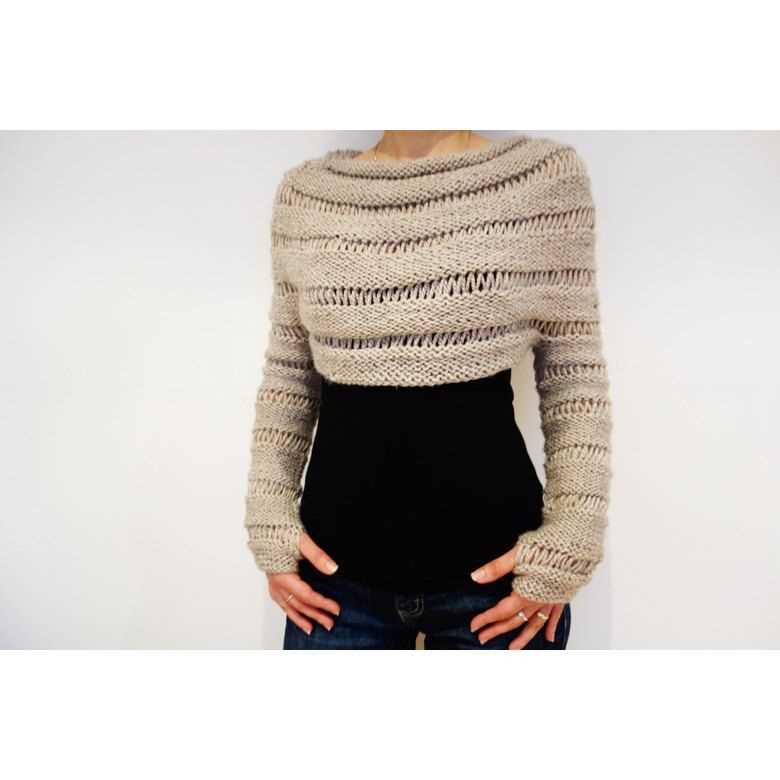
If you love knitting and are looking for a new project, why not try your hand at making a cropped sweater? Cropped sweaters are a stylish and trendy addition to any wardrobe, and with this knitting pattern, you can create your own unique design. Whether you’re a beginner or an experienced knitter, this pattern is suitable for all skill levels.
This knitting pattern for a cropped sweater is versatile and customizable. You can choose your favorite type of yarn, the color that best suits your style, and even adjust the length and sleeve size to create a sweater that fits you perfectly. The pattern includes step-by-step instructions and helpful tips, making it easy to follow along and complete your project.
Knitting a cropped sweater not only allows you to showcase your knitting skills but also gives you the opportunity to create a piece of clothing that you can wear with pride. Whether you plan on wearing it with high-waisted jeans, a skirt, or over a dress, a cropped sweater adds a touch of warmth and style to any outfit. So why wait? Start knitting your own cropped sweater today!
Knitting Pattern for Cropped Sweater
If you’re looking to add a trendy and stylish piece to your wardrobe, consider knitting a cropped sweater. This pattern is perfect for those who want to show off a little skin while still staying cozy. With its shorter length and loose fit, it can be paired with high-waisted jeans or skirts for a flattering and fashionable look.
To get started, you will need the following materials:
- Yarn: Choose a soft and medium weight yarn in the color of your choice. Approximately 500-600 grams.
- Knitting needles: Size US 8 (5mm) circular needles and double-pointed needles.
- Stitch markers
- Tapestry needle
Now, let’s dive into the pattern:
- Cast on 100 stitches using the circular needles.
- Join in the round and place a stitch marker to indicate the beginning of the round.
- Work in a rib stitch pattern (knit 1, purl 1) for 2 inches.
- Switch to stockinette stitch and knit every round until the piece measures approximately 10 inches from the cast on edge.
- Next, shape the armholes by binding off 4 stitches at the beginning of the next two rounds.
- Continue knitting in stockinette stitch until the piece measures approximately 14 inches from the cast on edge.
- For the neckline, bind off the center 20 stitches and complete each side separately.
- Continue knitting the front and back separately until each measures approximately 3 inches from the cast off edge of the armhole.
- Bind off all stitches and weave in any loose ends.
Once you’ve finished knitting, block the piece to give it a polished look. Sew up the side seams and you’re ready to show off your new cropped sweater! This pattern is customizable, so feel free to adjust the length and fit to your preference. Happy knitting!
Overview of the Cropped Sweater Pattern
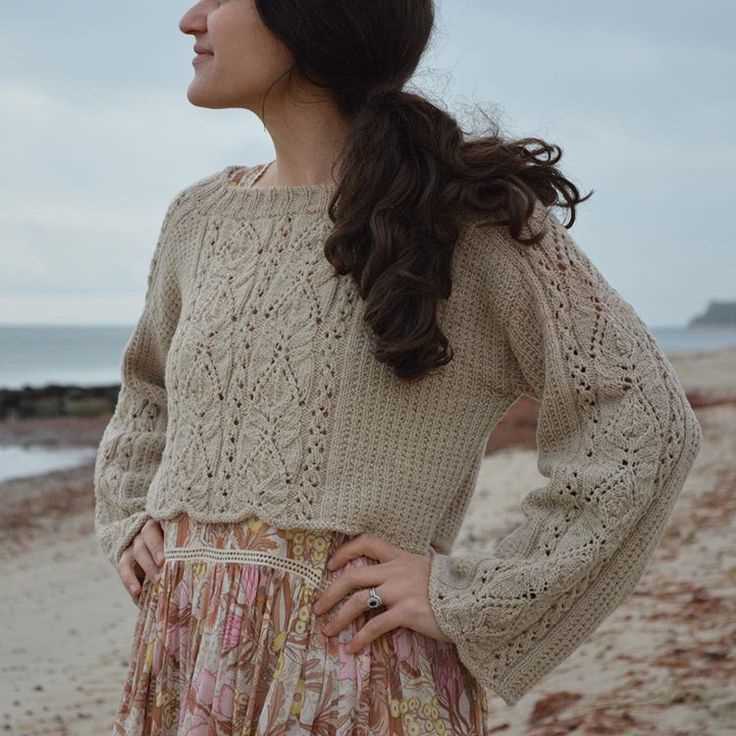
The cropped sweater pattern is a versatile and trendy design that is perfect for all seasons. With its shorter length and loose fit, it is an ideal choice for casual and stylish outfits. Whether you are a beginner or an experienced knitter, this pattern is easy to follow and will yield beautiful results.
This pattern is designed for intermediate knitters and requires knowledge of basic knitting stitches such as knit, purl, and increasing and decreasing stitches. The sweater is worked from the bottom up in a seamless construction, making it a quick and enjoyable project to complete.
The pattern calls for a medium-weight yarn and recommended needle size to achieve the desired tension and gauge. It uses a combination of knit and purl stitches to create a simple yet elegant textured pattern that adds visual interest to the sweater.
The cropped sweater features a boat neck and full-length sleeves, giving it a timeless and classic look. The sleeves are worked in the round using double-pointed needles or magic loop method, while the body is worked flat. The pattern also includes instructions for customizing the length of the sweater to suit your preferences.
In addition to the written instructions, the pattern also provides a chart for the textured pattern, making it easier to follow along. There is also guidance on how to properly block the finished sweater to ensure that it retains its shape and drapes beautifully.
Whether you are knitting this sweater for yourself or as a gift for a loved one, this cropped sweater pattern is sure to become a wardrobe staple. With its flattering fit and stylish design, it will be a go-to item that can be dressed up or down for any occasion.
Materials Needed for the Knitting Project
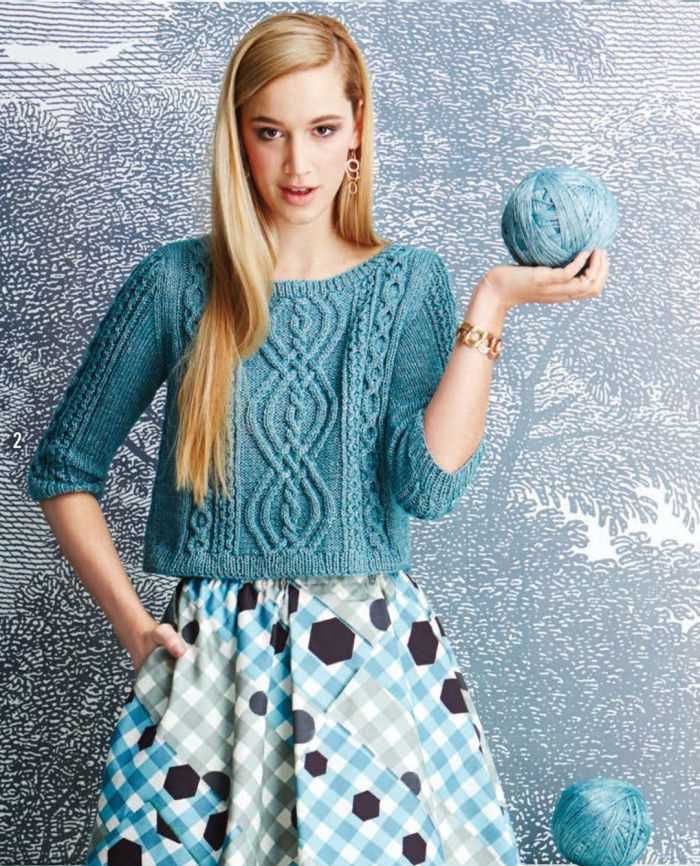
Before starting your knitting project for a cropped sweater, it is important to gather all the necessary materials. Here is a list of items you will need:
Yarn
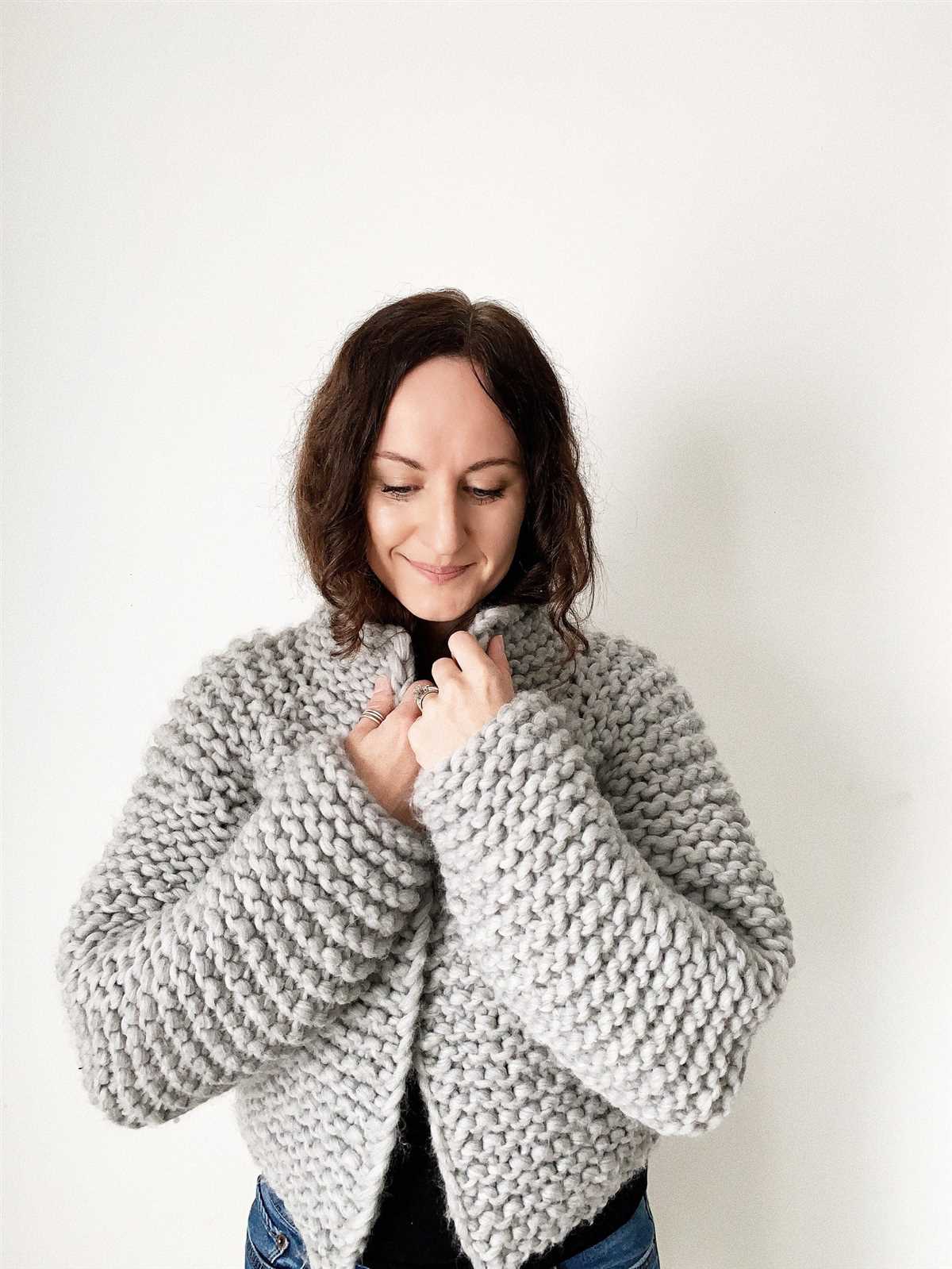
- Yarn Type: Choose a yarn that is suitable for the sweater pattern you will be using. Look for yarns labeled as “worsted weight” or “DK weight” for a medium-weight sweater.
- Yarn Color: Select a color that you love and that will match your style and wardrobe.
- Yarn Amount: The pattern will indicate the specific amount of yarn needed. Make sure to purchase enough to complete the sweater in your desired size.
Knitting Needles
- Needle Size: Check the pattern for the recommended needle size. Typically, a medium-sized needle around US 7 or 8 (4.5mm or 5mm) is used for worsted weight yarn.
- Straight Needles or Circular Needles: Choose the type of needles you prefer. Straight needles are used for flat knitting, while circular needles are used for knitting in the round.
- Length: The length of your needles will depend on the size of your sweater and your knitting method. If using circular needles, you will need a length that can accommodate the circumference of your sweater.
Notions
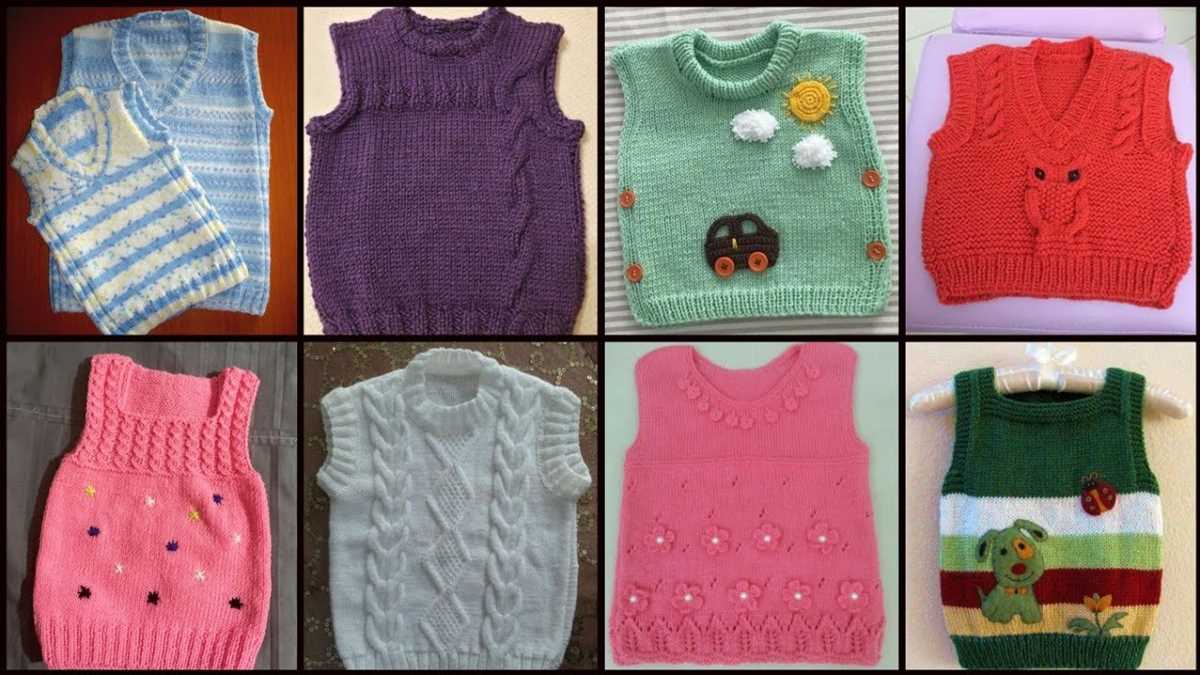
- Tape Measure: This will be used to measure your gauge and to check the size of your pieces as you knit.
- Scissors: You will need a pair of sharp scissors for cutting the yarn.
- Tapestry Needle: This needle will be used for seaming and weaving in loose ends.
- Stitch Markers: These are helpful for keeping track of stitch patterns and shaping.
- Row Counter: Use a row counter or a pen and paper to keep track of your rows and pattern repeats.
Once you have gathered all the necessary materials, you will be ready to start your knitting project. Remember to read through the entire pattern before beginning and to take your time to ensure accurate measurements and a successful finished garment.
Choosing the Right Yarn for Your Cropped Sweater
When it comes to knitting a cropped sweater, choosing the right yarn is essential to achieve the desired look and feel. The yarn you select will determine the drape, texture, and overall aesthetic of your finished garment. Whether you prefer a cozy, bulky sweater or a lightweight, breathable one, there are a few key factors to consider.
Fiber Content: The fiber content of the yarn will greatly impact the characteristics of your cropped sweater. Wool, for example, is a popular choice due to its warmth and ability to retain shape. Alpaca yarn, on the other hand, is known for its softness and drape. Cotton and linen are great options for warmer climates as they offer breathability and lightweight comfort. It’s important to consider the climate in which you’ll be wearing your sweater to ensure it’s suitable.
Weight: The weight of the yarn will dictate the thickness of your cropped sweater. If you’re looking for a chunky, oversized look, opt for a bulky or super bulky weight yarn. For a more fitted silhouette, a sport or DK weight yarn will be ideal. Consider the pattern you’ll be using and the desired outcome to determine the appropriate weight for your project.
Texture: Depending on the style you’re going for, the texture of the yarn can play a significant role. Smooth, worsted weight yarn can give your cropped sweater a clean and classic look, while a yarn with a halo effect, such as mohair or angora, can add a touch of whimsy and coziness. Consider experimenting with different textures to achieve the desired aesthetic.
Overall, choosing the right yarn for your cropped sweater is an exciting part of the knitting process. By considering factors such as fiber content, weight, and texture, you’ll be able to select a yarn that not only complements your pattern but also ensures that your finished garment is both stylish and comfortable.
Knitting Gauge and Needle Recommendations
When starting a knitting project, it is crucial to achieve the correct gauge in order to obtain the desired fit and size of the finished sweater. The gauge refers to the number of stitches and rows per inch or centimeter, and it can vary depending on the yarn, needle size, and individual knitting tension. To ensure accuracy, it is recommended to check the gauge before starting the cropped sweater.
Gauge: To determine the gauge, knit a swatch using the stitch pattern specified in the pattern. Use the recommended needle size and the chosen yarn to create a square swatch measuring at least 4 inches (10 cm) on each side. After completing the swatch, block it gently to relax the stitches. Then, count the number of stitches and rows within the designated area and compare it to the pattern’s gauge.
Needle Recommendations: The knitting needle size you choose can greatly affect the tension and drape of the fabric. It is advisable to use the needle size recommended in the pattern to achieve the intended results. However, if your gauge does not match the pattern’s gauge, you may need to adjust the needle size accordingly.
It is essential to remember that different knitters may have slightly different tensions, even when using the same yarn and needle size. Thus, it is highly recommended to first test the gauge swatch and make adjustments if necessary to ensure the best possible fit for the cropped sweater.
Getting Started with the Cropped Sweater Pattern
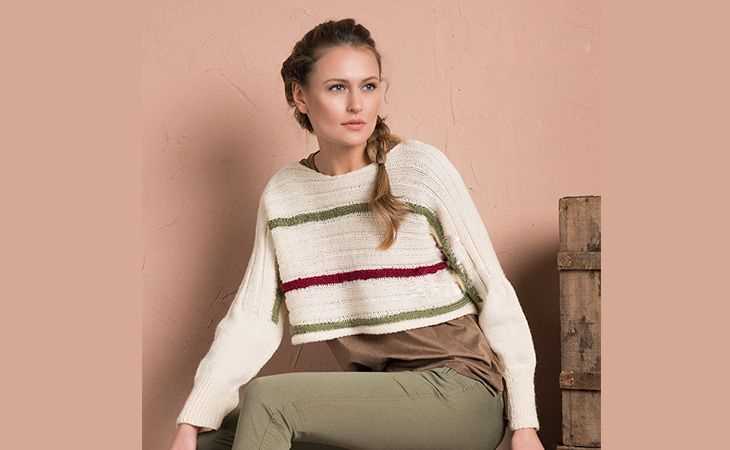
Welcome to the world of knitting and your journey to create the perfect cropped sweater! This knitting pattern is designed to provide you with all the information and guidance you need to successfully knit your own cropped sweater. Whether you are a beginner or an experienced knitter, this pattern will help you create a stylish and trendy sweater that you will be proud to wear.
Materials:
- Yarn: Choose a bulky or chunky weight yarn that is suitable for the desired gauge.
- Knitting needles: Use a pair of circular or straight needles in the size recommended on the yarn label or the size needed to obtain the correct gauge.
- Stitch markers: These will be helpful for marking stitch counts and pattern repeats.
- Tapestry needle or crochet hook: This will be used for weaving in ends and finishing details.
Gauge:
Before you begin knitting, it is important to check your gauge to ensure that your sweater will fit properly. The gauge is the number of stitches and rows per inch in the knitted fabric. To check your gauge, cast on a few stitches and knit a small swatch using the recommended needle size. Measure the swatch and compare it to the gauge given in the pattern. If your gauge does not match, you may need to change needle sizes to achieve the correct gauge.
Pattern:
The cropped sweater pattern consists of a combination of basic knit and purl stitches, as well as some shaping techniques like increasing and decreasing stitches. The pattern will guide you through each step, providing detailed instructions and stitch counts along the way. Make sure to read through the entire pattern before you begin, as it may include specific notes or tips that are important for your success.
Modifications:
Feel free to customize your cropped sweater by adding your own personal touches. You can experiment with different stitch patterns, change the length of the sleeves or body, or even add embellishments like buttons or pockets. Just remember to keep track of any modifications you make, especially if they affect the stitch counts or shaping instructions.
Finishing:
Once you have completed knitting the pieces of your cropped sweater, you will need to seam them together and finish any remaining details. Use the tapestry needle or crochet hook to weave in any loose ends, and make sure to block your sweater to give it a polished and professional look. Follow the finishing instructions provided in the pattern to achieve the best results.
With these tips and instructions, you are ready to embark on your knitting journey and create a fashionable cropped sweater. Enjoy the process and don’t forget to take pride in your finished creation!
Creating the Ribbing for the Hem and Cuffs
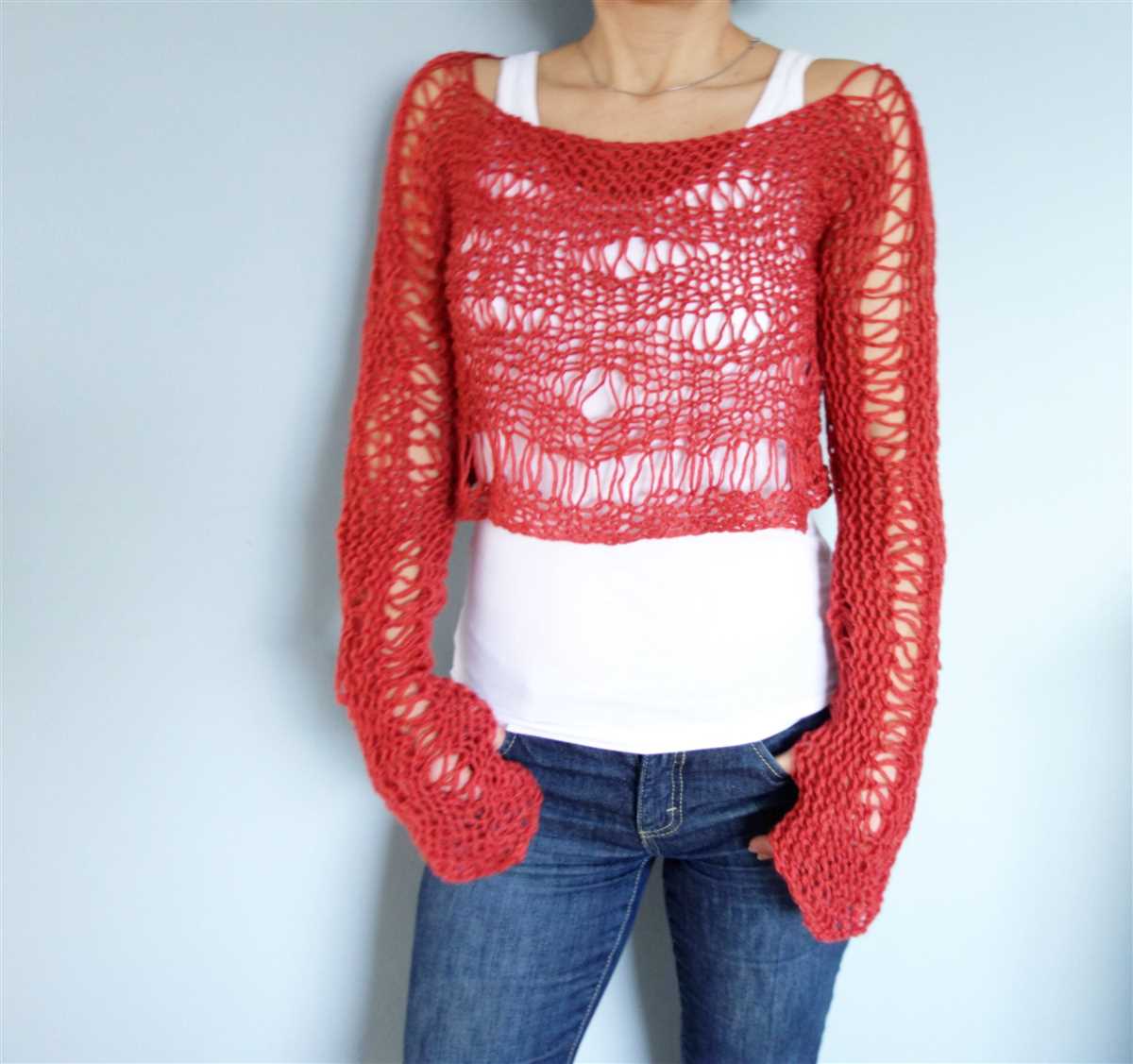
When knitting a cropped sweater, it’s important to create ribbing for the hem and cuffs to give the garment a polished and finished look. Ribbing is a technique that involves alternating knit and purl stitches to create a stretchy and textured fabric.
To begin creating the ribbing, cast on the desired number of stitches using a circular knitting needle. The ribbing for the hem and cuffs is typically worked in a smaller needle size than the main body of the sweater to create a tighter and more structured fabric.
The most common ribbing pattern for the hem and cuffs is the 1×1 rib. To work this pattern, knit one stitch and purl one stitch alternately across the row. Repeat this pattern for the desired number of rows. The 1×1 rib creates a neat and elastic edge that keeps the sweater in place and gives it a professional finish.
Another option for ribbing is the 2×2 rib, which involves knitting two stitches and purling two stitches alternately across the row. This pattern creates a slightly wider rib and adds more texture to the hem and cuffs. It can give your cropped sweater a more casual and relaxed look.
When you have completed the ribbing for the hem and cuffs, you can then move on to the main body of the sweater. The ribbing provides a clean transition between the fabric of the body and the edges, giving your cropped sweater a polished and professional appearance.
Knitting the Body of the Cropped Sweater
Once you have completed the ribbing for the hem of the cropped sweater, it is time to knit the body of the sweater. The body is worked in a combination of stockinette stitch and any additional stitch pattern or design elements you may choose.
Start by continuing in the main stitch pattern for the desired length of the body. This could be a simple stockinette stitch, or you could incorporate a textured stitch pattern like seed stitch or a cable design. You can also customize the body length based on your preferences and the desired cropped length.
Working the body of the sweater:
- Continue in the stitch pattern established in the ribbing section.
- Knit all stitches for one row to maintain the stockinette stitch pattern.
- Repeat the pattern rows until the body reaches the desired length. Remember to measure your work as you go to ensure the correct fit.
- If you are incorporating a stitch pattern or design element, make sure to follow the specified instructions for that pattern.
Once the body of the cropped sweater is complete, you can proceed to the next step, which is usually knitting the sleeves. Follow the instructions provided in the knitting pattern to complete the sleeves and any additional finishing touches for the sweater.
Remember to check your gauge throughout the knitting process to ensure that the final garment will have the desired fit. Happy knitting!
Shaping the Neckline and Shoulders
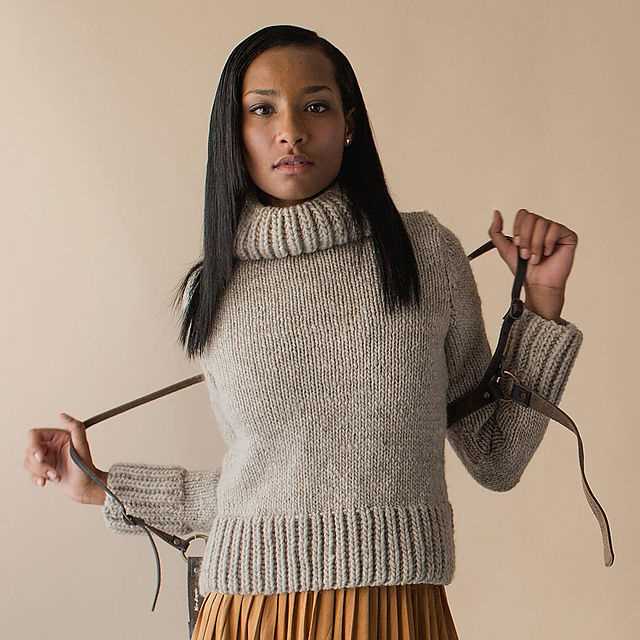
When knitting a cropped sweater, it is important to pay attention to the shaping of the neckline and shoulders to ensure a flattering and comfortable fit. These areas can greatly affect the overall look and feel of the garment.
To begin shaping the neckline, you will typically start with a number of stitches that are divided into front and back sections. You may need to decrease stitches gradually, using techniques such as knitting two stitches together or slipping stitches to create a smooth curve. The exact shaping method will depend on the specific pattern you are using, so be sure to carefully follow the instructions provided.
For the shoulders, you will usually work decreases on either side of the neckline to create a sloping effect. This helps to ensure that the sweater sits nicely on the shoulders and doesn’t bunch or sag. Again, the specific method for shaping the shoulders will vary depending on the pattern, so make sure to reference the instructions for guidance.
When shaping both the neckline and shoulders, it is important to maintain an even tension and keep track of your stitch count to ensure accuracy. Taking the time to carefully shape these areas will result in a well-fitting and stylish cropped sweater that you can be proud to wear.
Knitting the Sleeves of the Cropped Sweater
Once you have completed the body of the cropped sweater, it’s time to move on to the sleeves. The sleeves add the finishing touch to the garment and are an important part of the overall design. Here are some steps to help guide you through the process of knitting the sleeves.
1. Determine the length: Start by deciding how long you want the sleeves to be. Measure the desired length from your wrist to your underarm and make note of the measurement. This will help ensure that the sleeves are the perfect length for you.
2. Cast on stitches: With the desired length in mind, cast on the required number of stitches for the sleeve. You can refer to the knitting pattern for the specific number of stitches needed. It’s important to make sure your cast-on edge is not too tight or too loose, as this can affect the fit of the sleeve.
3. Work in the desired stitch pattern: Follow the knitting pattern to work the sleeve in the desired stitch pattern. This could be a simple stockinette stitch, a rib stitch, or any other pattern specified in the pattern. Make sure to keep track of your rows and stitches to maintain consistency throughout the sleeve.
4. Shape the sleeve: As you work the sleeve, you may need to shape it to create the desired fit. This can be done by increasing or decreasing stitches at certain points. The knitting pattern will provide guidance on when and how to shape the sleeve. Pay close attention to these instructions to ensure a proper fit.
5. Check your gauge: Throughout the sleeve knitting process, it’s important to check your gauge regularly to make sure you’re on track. Use a tape measure to measure the width and height of your work against the gauge specified in the pattern. This will help ensure that the finished sleeve matches the dimensions outlined in the pattern.
6. Finishing touches: Once you have completed the required number of rows and achieved the desired length for the sleeve, it’s time to finish off your work. Follow the pattern instructions to bind off the stitches and weave in any loose ends. This will give your sleeve a neat and polished look.
By following these steps and referring to the knitting pattern, you’ll be able to successfully knit the sleeves of your cropped sweater. Take your time, double-check your work, and enjoy the process of creating a beautiful and cozy garment.
Finishing Touches: Binding Off and Weaving in Ends
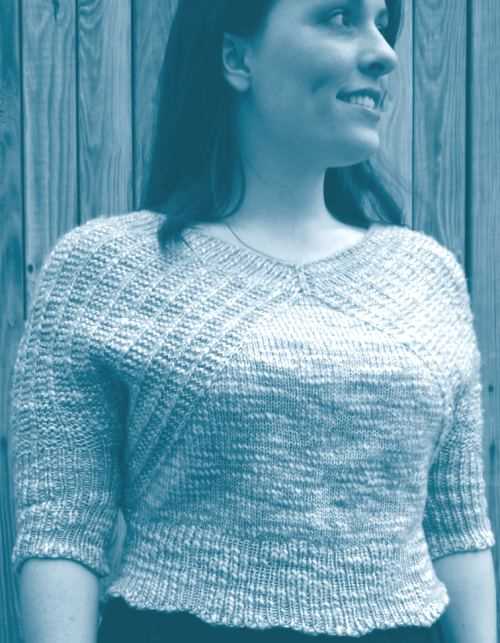
When it comes to completing your knitted cropped sweater, it is important to pay attention to the finishing touches, such as binding off and weaving in ends. These final steps not only ensure that your sweater looks professional and polished, but they also help to secure your stitches and prevent unraveling.
Binding off is the process of securing the final row of stitches on your needles. To bind off, knit the first two stitches as usual. Then, use your left needle to lift the first stitch over the second stitch and off the right needle. Knit the next stitch and repeat the process of lifting the previous stitch over the new stitch until you have only one stitch remaining on your right needle. Cut the yarn, leaving a tail of about 6 inches, and pull it through the last stitch to secure it.
Weaving in ends is the process of hiding and securing the loose yarn ends from your knitting. Use a tapestry needle to thread the yarn tail through the stitches on the wrong side of your knitted fabric. Weave the yarn in and out of the stitches for a few inches, making sure to go in different directions to prevent the end from coming loose. Once the end is secured, you can trim any excess yarn, leaving a small tail.
It’s important to pay attention to the finishing touches of binding off and weaving in ends to ensure that your knitted cropped sweater has a clean and professional look. Taking the time to properly bind off and weave in ends will not only make your finished garment more durable, but it will also give you a sense of accomplishment and pride in your knitting skills. So take your time, follow the instructions carefully, and enjoy the process of completing your beautiful cropped sweater.
Blocking and Care Instructions for Your Cropped Sweater
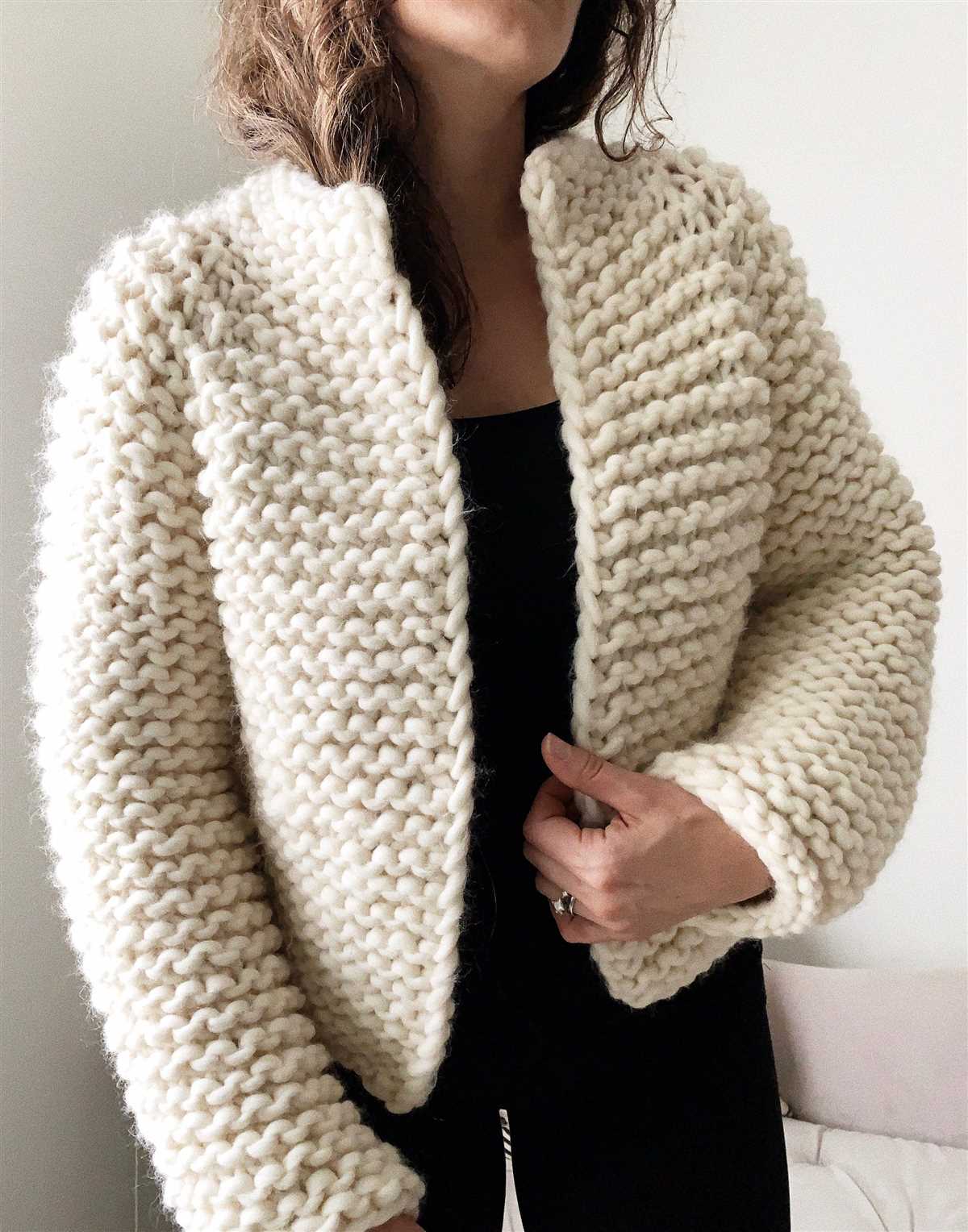
Blocking is an important step in the finishing process of your cropped sweater. It helps to even out any inconsistencies in the stitch pattern, relaxes the fibers, and gives your garment its final shape. To block your sweater, follow these steps:
- Fill a clean sink or basin with lukewarm water and add a mild detergent or wool wash.
- Submerge your sweater in the water, gently squeezing it to ensure it is fully soaked.
- Let the sweater soak for about 10-15 minutes.
- Remove the sweater from the water and gently squeeze out the excess water. Avoid wringing or twisting the fabric.
- Lay a clean towel on a flat surface and place the sweater on top, gently shaping it to its desired dimensions.
- Using rustproof T-pins, pin the edges of the sweater to the towel to hold it in place.
- Leave the sweater to dry completely, preferably away from direct sunlight or heat sources.
- Once the sweater is dry, unpin it and it’s ready to be worn!
To ensure your cropped sweater stays in great condition for years to come, here are some care instructions:
- Hand wash your sweater using a mild detergent or wool wash, and lukewarm water.
- Do not wring, twist, or agitate the fabric when washing.
- After washing, gently squeeze out the excess water and lay the sweater flat to dry.
- Avoid hanging your sweater as it can stretch the fabric.
- If necessary, you can lightly steam your sweater to remove any wrinkles or creases.
- Store your sweater folded or rolled to prevent stretching.
- Avoid storing your sweater in a damp or humid environment to prevent mold or mildew.
- If your sweater gets stained, spot clean it with a gentle detergent and water.
Following these blocking and care instructions will help your cropped sweater maintain its shape, softness, and overall quality for many seasons to come.
Tips and Tricks for Knitting a Perfect Cropped Sweater
In this article, we have discussed various aspects of knitting a cropped sweater, from choosing the right pattern to finishing the final touches. Here are some additional tips and tricks to ensure that your cropped sweater turns out perfect:
1. Take Accurate Measurements
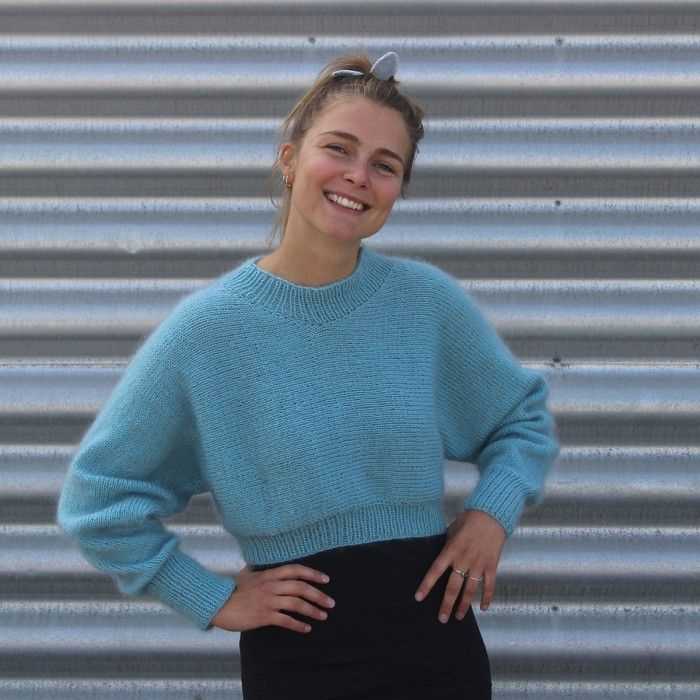
Before getting started, make sure to take accurate measurements of your bust, waist, and arm length. This will help you select the correct size and make necessary adjustments to the pattern for a perfect fit.
2. Use Quality Yarn
Invest in good quality yarn that is suitable for the pattern and your desired finished look. Utilizing high-quality yarn will not only enhance the appearance of your cropped sweater but also make it more comfortable to wear.
3. Check Your Gauge
Always make a gauge swatch to determine if you are knitting at the correct tension. This will ensure that your sweater will turn out the right size and fit as intended. Adjust your needle size if necessary to achieve the correct gauge.
4. Pay Attention to Pattern Instructions
Read and understand the pattern instructions thoroughly before starting your project. Familiarize yourself with any special techniques or stitches required and make sure you have a clear understanding of the shaping instructions.
5. Don’t Rush the Finishing
The finishing touches can make a significant difference in the final appearance of your sweater. Take your time to sew seams neatly, weave in ends securely, and block your sweater to ensure it looks polished and professional.
6. Make Swatches for Stitch Patterns
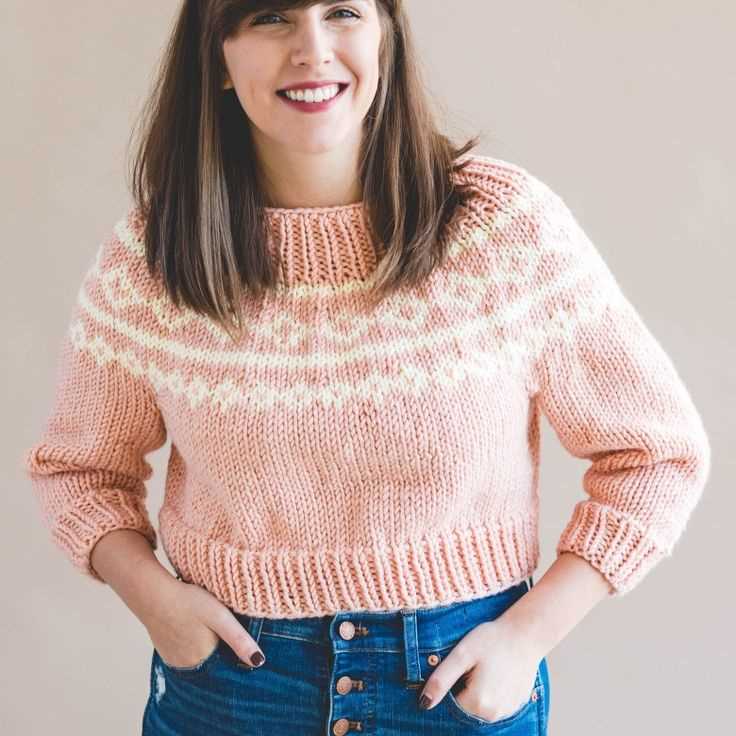
If your cropped sweater incorporates complex stitch patterns, consider making swatches to practice and ensure you understand the pattern correctly. This will help you avoid any mistakes or confusion while working on the final piece.
7. Take Breaks
Knitting a cropped sweater can be a time-consuming project. Remember to take breaks to give your hands and mind some rest. This will help you maintain focus and prevent fatigue or mistakes due to tiredness.
By following these tips and tricks, you’ll be well on your way to knitting a perfect cropped sweater that you’ll be proud to wear or gift to someone special!
Q&A:
What are some popular knitting patterns for cropped sweaters?
Some popular knitting patterns for cropped sweaters are “Daisy Crop Sweater,” “Cropped Cable Sweater,” “Easy Cropped Sweater,” “Boho Crop Sweater,” and “Mock Neck Crop Sweater.”
Where can I find knitting patterns for cropped sweaters?
You can find knitting patterns for cropped sweaters on various platforms such as knitting websites, online marketplaces like Etsy, crafting books, and knitting magazines.
What level of knitting skills do I need to make a cropped sweater?
Most cropped sweater patterns are suitable for intermediate or advanced knitters who are comfortable with techniques such as knitting in the round, increasing, decreasing, and reading complex patterns.
What materials do I need to knit a cropped sweater?
The materials you need for knitting a cropped sweater typically include the specific yarn recommended in the pattern, knitting needles in the appropriate size, stitch markers, a tapestry needle for sewing seams, and any specific notions mentioned in the pattern.
Can I adjust the length of a cropped sweater pattern?
Yes, you can adjust the length of a cropped sweater pattern to suit your preference. Most patterns provide instructions on how to modify the length, either by adding or subtracting rounds or rows as needed.
Where can I find a knitting pattern for a cropped sweater?
You can find knitting patterns for cropped sweaters on various platforms, such as online knitting forums, knitting pattern websites, and even on social media platforms. Some popular websites that offer a wide range of knitting patterns include Ravelry, LoveKnitting, and Etsy. You can search for specific keywords like “cropped sweater knitting pattern” to find the perfect pattern for your project. Additionally, many knitting magazines often feature patterns for cropped sweaters, so you can also check your local bookstore or library for knitting magazines.